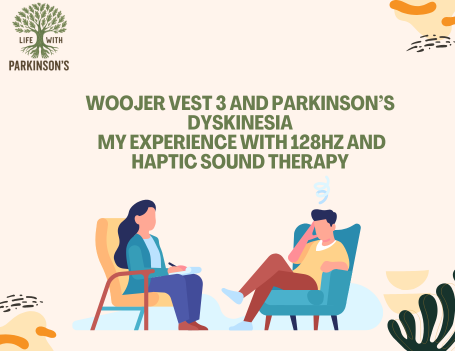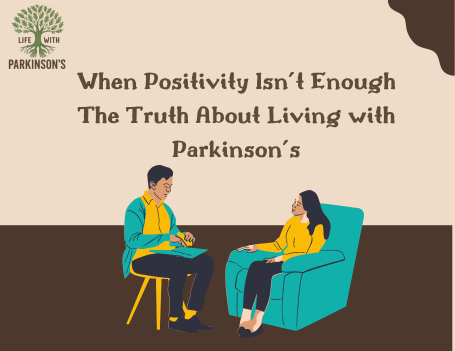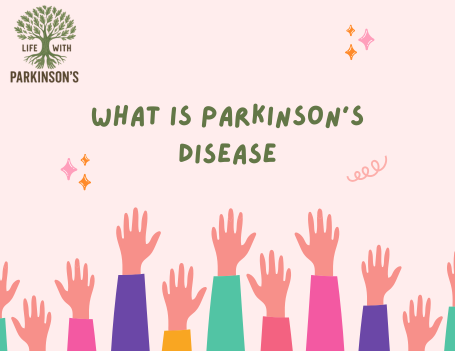Hi, I’m David Gebhart. I’m 44 years old, and I live in British Columbia, Canada. Back in May of 2017, I was diagnosed with Parkinson’s disease.
The type of Parkinson’s I have is more movement-related than tremor-based. I do get tremors, but mostly when I’m nervous. For example, if I’m recording a video, I’ll often notice them because speaking in front of a camera makes me anxious. On a day-to-day basis, though, tremors aren’t my biggest challenge. For me, stiffness and rigidity are the main symptoms that affect my life.
I want to share my diagnosis story — not only the appointment where I officially found out but also what happened in the years leading up to it. Looking back, there were many signs, and some of them were easier to see than others. By putting it all together, I hope it helps others recognize what might be happening in their own lives or with someone they care about.
Early Signs Before My Diagnosis
When I look back, I can see the first signs of Parkinson’s showing up as early as 2012 and 2013. At the time, I had no idea that’s what they were. I just thought I was dealing with work stress, getting older, or maybe pushing my body too hard.
Struggling at Work
I worked as an overhead door technician, which is a very physical job. It involves lifting heavy garage doors, carrying equipment up ladders, and working with lots of small nuts, bolts, and components.
I remember one of the first symptoms really clearly. I was on the job with a coworker I spent a lot of time with, and I kept joking to myself, “Come on, left hand, you can do it.” My fine motor movements in my left hand just weren’t working the way they should. Something as simple as screwing on bolts or handling tools felt awkward and clumsy. Even today, I still struggle with those same movements.
Cognitive Struggles
Around the same time, I also noticed changes in my memory. Later, I was diagnosed with mild cognitive impairment, which basically means my brain still stores information, but it takes longer to pull it out — like trying to open a sticky drawer.
Back in 2013, it showed up in a stressful situation at work. I’m second-in-command at my company, so when my boss — who is also a close friend — was away, I had to step up.
Usually, that wasn’t a problem. I’d make decisions, handle what came up, and keep things running until he returned.
But this time was different. I was faced with a tough decision, and instead of managing, I completely froze. The stress became overwhelming, and I didn’t know what to do. In the end, I actually had to call my boss at his hotel in another country to ask for help.
That was embarrassing for me, because I’d handled tough situations in the past. Even if I didn’t always make the exact same choices he would have, I got through them. But in this case, I couldn’t. That was one of the first big red flags — not just for me, but for my family too. My wife was so concerned she even spoke to her dad, trying to figure out what was happening with me.
Physical Progression
From 2013 onward, the physical symptoms got worse. I was constantly trying to figure out what was wrong with me. Was it just my work wearing me down? Was I aging faster than I should? I was only in my late 30s — 37, 38, 39, 40 — so I shouldn’t have been struggling this much.
I tried everything I could think of: changing my footwear, changing my clothes, getting massages. A massage would make me feel better for a few hours, but by the next morning, it was like nothing had happened. That was incredibly frustrating.
Most of the problems were on my left side. It started in my hand, then spread to my shoulder, down my leg, and into my foot. My left shoulder became especially difficult to manage, and in my line of work, that mattered a lot. Winding springs — which involves a lot of overhead arm movement — became painful and awkward. I used to joke that I had “spring winding syndrome,” but deep down, I knew something more was going on.
Eventually, I even developed a limp in my left leg. At first, I thought it might have been connected to an old injury on my right foot, where I’d had three surgeries. But that didn’t make sense. If my right foot had been injured, why was my left side the one getting weaker and stiffer?
At the time, none of it added up. I just knew that something wasn’t right.
Loss of Smell and Vision Problems
Up to this point, I hadn’t experienced tremors, which many people associate with Parkinson’s. But my sense of smell started to fade. My wife or coworkers would comment on odors I couldn’t detect — smells of garbage, propane, paint, or other strong scents — and I simply couldn’t smell them. It was subtle at first, but consistent.
By 2015, I began experiencing vision problems, like temporary double vision. It wouldn’t happen all the time, but in certain situations, the doubling could last two to three minutes. Blinking or closing my eyes helped, but it was another unusual symptom that added to my concern.
Emotional Changes and Routine Dependence
In 2016, I started noticing emotional changes. Stressful situations at work became harder to handle. I would lose control in conversations or become emotional over small things. Deep discussions with my wife sometimes led to crying — something that had never happened before.
My routines became extremely important. If a schedule changed, even something minor like walking the grocery aisles differently, I would become upset or disoriented. My memory was also affected. I began forgetting details about my children, conversations with family members, or even recent events.
Mexico Missions Trip
In October 2016, we went on a missions trip to Mexico to help build a school. By this time, my motor symptoms had progressed, and I struggled with tasks I normally handled with ease. One of the main things I helped with was wiring — running wires, connecting circuits, and organizing electrical work. But my left hand simply wouldn’t cooperate, and completing even basic tasks became frustrating.
Life at Home and School
In early 2017, alongside my full-time job, I had enrolled in a seminary school to train as a pastor. I was taking courses on the side, committing 10 to 15 hours per week to schoolwork on top of 40–45 hours of work, plus family and church responsibilities. My schedule was packed, and I thought that the stiffness and mental fatigue I was experiencing were due to the stress of managing all these commitments.
At first, I tried pacing myself. I delegated some church responsibilities to others and reduced household chores, hoping that would ease the strain. Despite these efforts, I found that schoolwork became increasingly difficult. Writing essays, which had always been something I excelled at, now took far longer. A task that might have taken me an hour in the past could take a whole week. I became extremely anxious and nervous, particularly when
I had to present or speak in front of the class.
This anxiety also triggered my first noticeable tremors, which would appear when I was speaking publicly. Growing up, I had performed on the piano and sang in front of audiences — sometimes over a hundred people — and had never experienced stage fright. But now, even a small classroom presentation caused my hands to shake, which was alarming and confusing.
The combination of cognitive slowdown, memory lapses, and physical limitations made schoolwork much more challenging. I struggled to recall details for essays, and my ability to focus was inconsistent. These academic struggles, alongside my professional and personal responsibilities, added another layer of stress to an already complex situation.
Managing Stress and Life
We were casual with our family doctor, so I felt comfortable sharing almost everything going on in my life — both at work and at home. He listened patiently and advised that before making any major life changes, such as moving apartments or adjusting responsibilities, I should make sure I had medical treatment available wherever I was going. It wasn’t a warning, just practical advice, but looking back, it was very prescient.
Around this time, I was considering buying an apartment closer to the seminary school I had enrolled in. I was excited about the idea — closer to classes, more time for study, less commuting — and I was ready to go ahead. However, my wife disagreed with the plan.
She was concerned about the timing, the financial stress, and the fact that I was already juggling so many commitments. The discussion escalated into a big argument, with back-and-forth tension over whether we should proceed. I was determined, but she firmly put her foot down, saying, “No, we’re not going to do that.”
In the end, I caved in and listened to her, pausing the apartment purchase. At the time, I felt frustrated and conflicted, but looking back, it gave me the space to focus on what was really happening with my health. The stiffness, mental strain, and emotional tension I was experiencing were becoming hard to ignore, and this pause allowed me to take a closer look at those issues before making any more life-altering decisions.
Family First Notices Something Is Wrong
In March 2017, I attended a family funeral. While I thought I was managing my stiffness fairly well, my uncle noticed something was off. He began quietly asking others, “Is there something wrong with David? He doesn’t look well.”
For me, that moment was unsettling. I didn’t think much was wrong — just a bit of stiffness, I told myself. But it was becoming clear that those closest to me could see changes I hadn’t fully accepted.
Mental and Academic Struggles Begin
Around this same time, my mental symptoms were intensifying. Tasks that had always come easily now became uphill battles.
I had been a strong essay writer, yet suddenly, even forming a single sentence could take me an hour. It reached the point where I had to take an entire week off work just to complete one assignment — something that had never happened to me before.
These academic struggles weren’t just frustrating; they were alarming. They revealed that my condition was affecting more than just my physical abilities — it was seeping into my concentration, memory, and cognitive function.
Tremors in Public Speaking
I also began noticing changes in situations that once brought me confidence. Speaking in front of people, for example, became a trigger for tremors.
I remember when the pastor asked me to read a passage at church. As I stood in front of the congregation, my hands started shaking uncontrollably. This was so unlike me. Growing up, I had played piano and sung in front of audiences of one or two hundred people without the slightest nervousness. Now, something as simple as reading aloud left me trembling.
This shift marked one of the strangest and hardest parts to accept — losing control over situations where I had once thrived.
A Sunday Neurologist Visit
By May 2017, my family doctor had become more and more concerned about what was happening with me. I had been seeing him every couple of weeks for an unrelated problem — plantar warts on my left foot. During those appointments, though, he kept noticing my stiffness and the other things I mentioned.
On May 28, 2017, he finally referred me to a neurologist. What made it stand out was the day: it was a Sunday. Normally, specialists don’t see patients on Sundays, but my doctor pushed for it because he wanted me to be seen as soon as possible. That in itself showed just how worried he really was.
When we went in, the neurologist explained that the appointment would have three parts: first a questionnaire, then a physical examination, and finally, his diagnosis.
The Neurologist’s Three-Part Evaluation
1. The Questionnaire
The questioning took the longest. He asked if I had ever been exposed to toxins or pesticides. Then he asked about dreams — not just ordinary ones, but whether I had violent dreams. I had to admit that yes, I had, and lately they had become extremely vivid and disturbing in a way they hadn’t been before.
He went on to ask about alcohol and drugs. I was open about it: I drank occasionally, and there were times in my life when I had smoked marijuana.
Next came my sense of smell. That was when something clicked for me — I realized how much I had actually lost, even though I hadn’t fully noticed it until that moment.
He asked about vision problems, accidents, surgeries, and family history. I told him about injuring myself while playing basketball years ago, which had required surgery. I also explained about a workplace accident where I fell off a ladder and ended up needing three surgeries on my foot. In my family history, I mentioned varicose veins, and possibly a great-uncle who might have had Parkinson’s, though I wasn’t certain.
2. The Physical Examination
After the questions, he moved on to the exam. He asked me to walk up and down the hallway while he watched. As I walked, my left arm just hung there at my side, not swinging like it should.
He tested my reflexes in my knees and elbows. He asked me to snap my fingers, flip my hands over quickly, touch my nose, and follow his finger with my eyes. At one point, he had me touch a cold object, comparing how it felt between my two hands. Strangely, my right hand registered it as much colder than my left.
Throughout the exam, he kept murmuring little sounds — “hmm” — which left me feeling curious but also uneasy.
3. The Diagnosis
When it came time for the diagnosis, my neurologist was very gentle and cautious. I really liked his approach. He didn’t immediately say “Parkinson’s.” Instead, he referred to my condition as parkinsonism. He explained that my symptoms presented quite uniquely, especially since I didn’t have a lot of tremor, which made the diagnosis more difficult.
Because of that, he wanted to be absolutely sure before giving me a firm answer. He ordered a large number of blood tests — at least five or six bottles were filled that day, with almost every box on the lab form checked off. On top of that, I went through two separate MRIs at different times.
He also arranged for me to see another neurologist. That second opinion confirmed his initial findings. He explained that the reason for all these tests and referrals was to rule out other diseases and causes, since Parkinson’s is a clinical diagnosis. There isn’t one single blood test that says yes or no. It’s based on questions, answers, and observed symptoms.
Finally, he told me about what he called the “big test” — taking Sinemet, a combination of levodopa and carbidopa. He explained that if this medication worked, it would strongly suggest that Parkinson’s was the correct diagnosis.
I filled the prescription that same day and took my first pill the next morning. Almost immediately, my symptoms improved. That response to the medication essentially confirmed it: I did, in fact, have Parkinson’s disease.
Conclusion
My Parkinson’s diagnosis wasn’t a single moment — it was a long journey of subtle changes, missed signs, and mounting concerns from the people around me. Looking back, the stiffness, loss of smell, vision problems, cognitive struggles, emotional changes, and tremors were all pieces of the same puzzle. At the time, though, none of it seemed to add up.
It took persistence from my family, my family doctor, and eventually my neurologist to put those pieces together. The process was thorough, sometimes overwhelming, but necessary. From detailed questioning and physical exams to multiple tests and second opinions, every step was about ruling out other causes before landing on the right answer.
When I finally started medication and felt my symptoms improve almost immediately, it was both a confirmation and a turning point. I had Parkinson’s. The uncertainty was gone, and while the reality was difficult to accept, it gave me clarity.
If you’re noticing symptoms in yourself or someone you love, don’t ignore them. Parkinson’s looks different for everyone, but early recognition and medical attention make a real difference. My story is just one example of how the journey unfolds — unique, sometimes confusing, but ultimately leading to answers.
Support My Journey
If you’ve found my story helpful and would like to support me in continuing to share my experiences, you can do so here:👉 Support me on Ko-fi
Every contribution, no matter how small, helps me keep creating these resources for people living with Parkinson’s and their loved ones.
A Note from Me
Telling my diagnosis story wasn’t easy, but I share it because I know how isolating and confusing these first years can be. Everyone’s Parkinson’s journey looks a little different, but sometimes hearing another person’s path can make your own feel less overwhelming. Thank you for taking the time to read mine.
Caregiver’s Corner
If you’re a caregiver, family member, or close friend of someone with Parkinson’s, your role is invaluable. Often, loved ones notice symptoms before we do — just like my uncle did at that funeral. Trust your instincts, and don’t hesitate to gently encourage medical attention when something feels off. Your support can make a world of difference.
Disclaimer
I am not a medical professional. This blog reflects my personal experience of being diagnosed with Parkinson’s disease. Parkinson’s symptoms and progression vary from person to person, and what applied to me may not apply to someone else.
If you or someone you love is experiencing similar symptoms, please seek advice from a qualified healthcare professional. For more information, you can visit reputable sources such as:
- Parkinson’s Foundation
- Michael J. Fox Foundation



